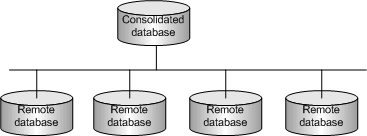Both MobiLink and SQL Remote provide data synchronization between a central database and a set of remote databases.
In MobiLink, the consolidated database is one of several supported RDBMSs. The consolidated database, which typically resides on a corporate server, tracks synchronization information and optionally contains the data to be replicated. Other central data may be stored in any other format, such as a non-relational database, web service, or text file.
MobiLink also provides direct row handling, which enables data synchronization to consolidated data sources other than relational databases including enterprise resource planning (ERP) systems or application servers.
In SQL Remote, all data that is to be synchronized is contained in a SQL Anywhere consolidated database.
A remote database can run either at the same site as the consolidated database or at a physically distant site such as a handheld device. The remote database can share all or some of the data in the consolidated database.
The following figure displays a schematic illustration of a small synchronization system.

A typical synchronization system includes many remote databases. Each remote database contains a subset of the information in the central database. Each remote database is a physically separate database, usually on a separate computer or mobile device. All remote databases must stay consistent with the central database.
The entire synchronization system may be considered a single dispersed database, with the master copy of all shared data being kept at the central database.
Each remote site that synchronizes with the central database is considered to be a remote user of the central database. In the case that a remote site is a multi-user server, the entire site is considered to be a single remote user of the central database.
Hierarchical database configurations
Two-way synchronization
| Send feedback about this page via email or DocCommentXchange | Copyright © 2008, iAnywhere Solutions, Inc. - SQL Anywhere 11.0.0 |